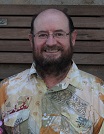Fire in Australia: how was the biota prepared for human occupation?
Robert S. Hill A C and Gregory J. Jordan BA School of Biological Sciences, The University of Adelaide, SA 5005, Australia.
B School of Biological Sciences, University of Tasmania, Private Bag 55, Hobart, Tas, 7001, Australia.
C Correpsonding author. Email: bob.hill@adelaide.edu.au

Professor Bob Hill is Executive Dean of the Faculty of Sciences and Director of the Environment Institute at the University of Adelaide. He is also Head of Science at the South Australian Museum. His research interests focus on the evolution of the Australian vegetation over the last 60 million years, a period of time that saw most major aspects of the living vegetation come into existence. His particular research focus has been on the major Southern Hemisphere angiosperm genus Nothofagus and the evolution and distribution of the southern conifers. He has an ongoing interest in the interactions between soil nutrients, water availability and fire on the evolution of the living Australian vegetation. He has edited four books and has over 250 scientific publications. |

Associate Professor Greg Jordan is a research/teaching academic at the University of Tasmania, in the School of Biological Sciences in the Faculty of Science, Engineering and Technology. For the last 25 years he has been using evidence from fossils, geographic distributions, ecology, phylogeny and physiology to study plant evolution and biogeography, especially of the southern hemisphere. |
Australian Journal of Botany 64(8) 555-556 https://doi.org/10.1071/BTv64n8_ED1
Published: 19 December 2016
References
Carpenter RJ, Holman AI, Abell AD, Grice K (2016) Cretaceous fire in Australia: a review with new geochemical evidence, and relevance to the rise of the angiosperms. Australian Journal of Botany 64, 564–578.| Cretaceous fire in Australia: a review with new geochemical evidence, and relevance to the rise of the angiosperms.Crossref | GoogleScholarGoogle Scholar |
Foreman P (2016) A framework for testing the influence of Aboriginal burning on grassy ecosystems in lowland, mesic south-eastern Australia. Australian Journal of Botany 64, 626–642.
| A framework for testing the influence of Aboriginal burning on grassy ecosystems in lowland, mesic south-eastern Australia.Crossref | GoogleScholarGoogle Scholar |
Hill RS, Jordan GJ (2016) Deep history of wildfire in Australia. Australian Journal of Botany 64, 557–563.
| Deep history of wildfire in Australia.Crossref | GoogleScholarGoogle Scholar |
Hill RS, Beer Y, Hill K, Maciunas E, Tarran M, Wainman C (2016) Evolution of the eucalypts – an interpretation from the macrofossil record. Australian Journal of Botany 64, 600–608.
| Evolution of the eucalypts – an interpretation from the macrofossil record.Crossref | GoogleScholarGoogle Scholar |
Johnson CN (2016) Fire, people and ecosystem change in Pleistocene Australia. Australian Journal of Botany 64, 643–651.
| Fire, people and ecosystem change in Pleistocene Australia.Crossref | GoogleScholarGoogle Scholar |
Macphail MK, Thornhill A (2016) How old are the eucalypts? A review of the microfossil and phylogenetic evidence. Australian Journal of Botany 64, 579–599.
| How old are the eucalypts? A review of the microfossil and phylogenetic evidence.Crossref | GoogleScholarGoogle Scholar |
Sluiter I, Blackburn DT, Holdgate G (2016) Fire and Late Oligocene to Mid-Miocene peat mega-swamps of south-eastern Australia: a floristic and palaeoclimatic interpretation. Australian Journal of Botany 64, 609–625.
| Fire and Late Oligocene to Mid-Miocene peat mega-swamps of south-eastern Australia: a floristic and palaeoclimatic interpretation.Crossref | GoogleScholarGoogle Scholar |


